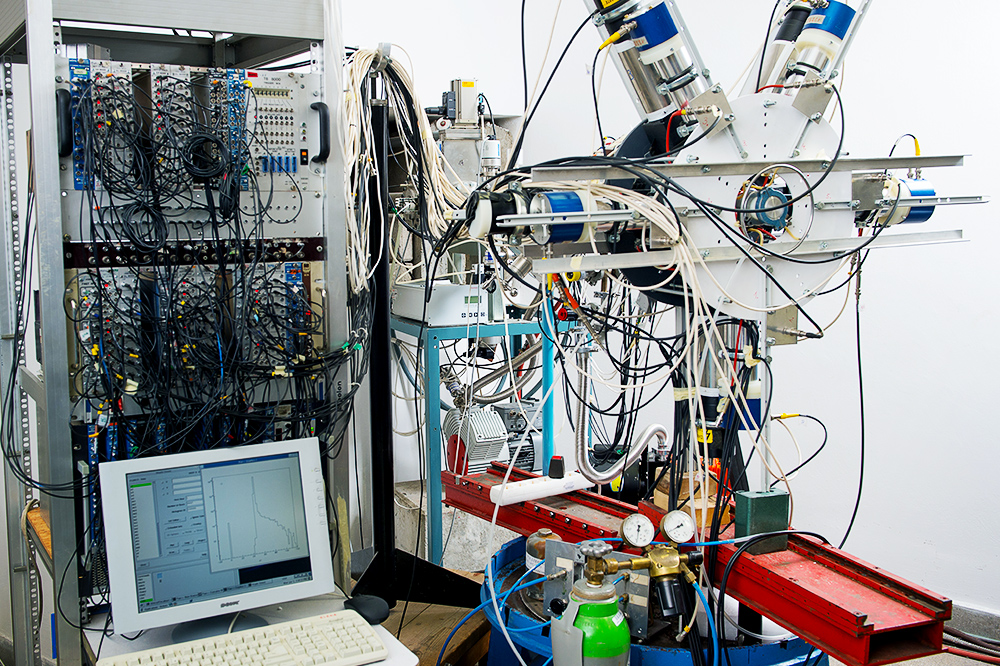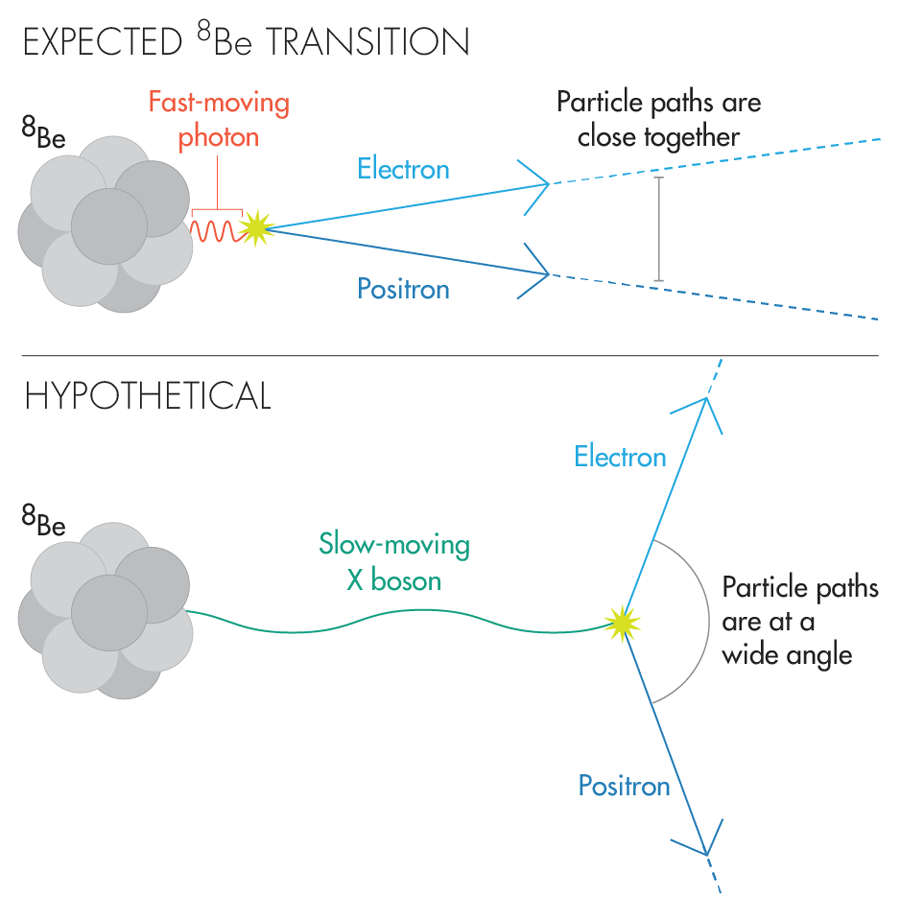Evidence of a ‘Fifth Force’ Faces Scrutiny

Last year, a team of nuclear physicists in Hungary observed an anomaly in the decays of excited beryllium-8 atoms — an unexpected preference for spitting out pairs of particles with a particular angle of separation. The bump in the physicists’ data was unmistakable, with odds of less than one in 100 billion of arising by chance. Reporting the anomaly in Physical Review Letters in January, the researchers argued that it could signify the existence of a new fundamental particle. But at first, few took notice.
That changed in April with a much-discussed paper by Jonathan Feng, a theoretical particle physicist at the University of California, Irvine, and colleagues. After spending months translating the nuclear physics finding into the language of particle physics and ensuring that no particle physics experiments contradicted it, the Irvine team determined that the beryllium-8 anomaly is “beautifully” explained by the presence of a previously unknown “vector boson” — a type of particle that would wield a little-felt fifth force of nature.
The proposed boson has become lunch-table talk in physics departments far and wide, and plans are afoot for testing the idea. If the particle is confirmed, it would be a definite “ticket to Stockholm” that “would completely upend our understanding of the universe,” said Jesse Thaler, a theoretical particle physicist at the Massachusetts Institute of Technology. Unlike the Higgs boson — the particle discovered in 2012 that was the last missing piece of the Standard Model of particle physics — this unforeseen boson and accompanying force would lead the way to a more complete theory of nature. Physicists desperately seek an extension of the Standard Model to account for dark matter, neutrino masses, unification of the forces and other mysteries. (In a forthcoming paper, the Irvine team will propose a Standard Model extension that includes the new boson.) Stressing that he has a high bar for experimental anomalies after seeing many bumps come and go in the past, Feng said, “I’m more excited than I’ve been about things for a long time.”
Remarkably, whereas the world’s biggest supercollider was needed to produce the heavy Higgs boson, the hypothetical Hungarian boson is so lightweight, with a mass only 34 times that of the electron, that it could have turned up in experiments decades ago. If it really exists, how did it go unnoticed for so long? Most experts will remain skeptical until further evidence of the particle rolls in — even Feng. “It’s a huge claim to say a fifth force has been discovered, and I recognize that,” he said. “Obviously, you need to check it.”
Rouven Essig, a theoretical particle physicist at Stony Brook University who described himself as “very skeptical,” said that “it would be crazy not to check, because if it’s true it will be fantastic; it will be a rewriting, a huge deal.”
But even as interest mounts, so has scrutiny of the Hungarian experiment, and red flags have emerged. Oscar Naviliat-Cuncic of Michigan State University, a nuclear physicist who has examined the history and credentials of the Hungarian group more closely than most, now seriously doubts their report. “It’s, for me, sort of incredible that that was published in Physical Review Letters,” he said.
A Bold Claim
None of the other physicists interviewed for this article had heard of the researchers at the Institute for Nuclear Research at the Hungarian Academy of Sciences (Atomki) in Debrecen before their audacious claim appeared on the scientific preprint site arxiv.org in April 2015. Even then, word did not spread. Bartosz Fornal, a postdoctoral researcher at Irvine, came across the preprint completely by chance in December, in a Google search. Though it had garnered no citations in the intervening months, Fornal, Feng and their colleagues were intrigued. They attributed the radio silence to the culture gap separating nuclear and particle physics: “Nuclear physicists didn’t know what to make of it” since claims of new particles are not really their thing, Feng said, “and particle physicists, who are of course extremely interested in any sign of a new particle, simply don’t read the [experimental nuclear physics] arxiv listings.”
In a paper of their own posted on arxiv.org in April of this year and submitted for publication, the Irvine team described the Atomki scientists’ result as follows: When a beryllium-8 nucleus undergoes a particular transition, it sheds energy and typically one unit of quantum spin — almost always in the form of a particle of light, or photon, which is the mediator of the electromagnetic force. Sometimes, the photon immediately decays into an electron and a positron, which are propelled forward by the photon’s momentum and strike the detector near one another. But for every million photon decays, one time, Feng and his colleagues hypothesize, beryllium-8 yields a different kind of vector boson, temporarily dubbed X, which mediates an obscure new fundamental force. (The four known forces are electromagnetism, gravity, and the strong and weak interactions.) This slow-moving X boson, which has a mass of 16.7 million electron volts (MeV), splits into an electron-positron pair. Because they do not get as big a forward push as the decay products of photons, the X boson’s remnants diverge at a wider angle, striking the detector at about 140 degrees.

Lucy Reading-Ikkanda for Quanta Magazine
A different experiment had already searched for and ruled out the simplest version of such a particle — a 16.7-MeV “dark photon,” which would interact with the known particles in the same way (albeit more rarely) as a normal photon, and would also interact strongly with unknown dark-matter particles. But, starting with an idea by Susan Gardner, a member of the Irvine group on sabbatical from the University of Kentucky, the group devised a variation that hadn’t been ruled out: The X boson may have avoided earlier detection because it interacts with protons and neutrons in the opposite way that photons do. Instead of interacting with protons and ignoring neutrons, the proposed X boson interacts with neutrons but is “protophobic,” ignoring protons.
Researchers have already begun looking for evidence of the protophobic boson in existing data from LHCb, a particle physics experiment at Europe’s Large Hadron Collider. In the coming years, experiments at Triangle Universities Nuclear Laboratory in Durham, N.C., Thomas Jefferson National Accelerator Facility in Newport News, Va., and elsewhere could also confirm or rule out the existence of the particle.
But when coverage of the fifth-force theory and plans to test it appeared recently in Nature News, Naviliat-Cuncic, who does nuclear-decay experiments, read it with raised eyebrows. “It seems that people get excited about it, but do not go and read [the Hungarian group’s] past work,” he said.
A Pandemonium of Bosons
The Atomki group has produced three previous papers on their beryllium-8 experiments — conference proceedings in 2008, 2012 and 2015. The first paper claimed evidence of a new boson of mass 12 MeV, and the second described an anomaly corresponding to a 13.45-MeV boson. (The third was a preliminary version of the Physical Review Letters paper.) The first two bumps have disappeared in the latest data, collected with an improved experimental setup. “The new claim now is [a] boson with a mass of 16.7 MeV,” Naviliat-Cuncic said. “But they don’t say anything about what went wrong in their previous claims and why we should not take those claims seriously.” One naturally wonders, he said, “Is this value that they quote now going to change in the next four years?”
In their papers and in an email, the Hungarian group expressed gratitude to Fokke de Boer, a Dutch physicist who led their experiments from 2001 to 2005. Naviliat-Cuncic’s sleuthing revealed that de Boer had been reporting anomalies in nuclear transitions and attributing them to missing bosons for decades, seldom replicating his results from one experiment to the next. In his years at Atomki, de Boer detected multiple anomalies in beryllium, carbon and oxygen nuclear transitions — evidence, he claimed, of “a pandemonium of more than 10 candidate bosons.”
When the team upgraded their experimental apparatus, the boson pandemonium disappeared. “He was very unhappy that we could not confirm his previous results with our new spectrometer,” said Attila Krasznahorkay, the current leader of the Atomki group. De Boer’s bosons failed to reappear in the group’s subsequent findings, but as they tweaked their instruments, they continued to strike upon new possibilities. This time, Krasznahorkay said, “We are very much confident about our experimental results.” De Boer, who died in 2010, was not involved in the new work.
When pressed, Krasznahorkay did not fully explain the disappearance of the earlier anomalies. He did not mention the 12-MeV bump and claimed that the 13.45-MeV bump was actually the 16.7-MeV one, incorrectly measured — a possibility that Naviliat-Cuncic considers unlikely when comparing the two bumps. Martin Savage, a cross-disciplinary nuclear and particle physicist at the University of Washington, agrees that the explanation seems unlikely, but said that even if it is true the unstated assumptions in the faulty 13.45-MeV measurement raise concerns. “If a scientific collaboration is making a claim about discovering a new particle, they are obligated to understand and estimate the systematic uncertainties associated with their measurements,” he said. “As far as the 12-MeV signal is concerned, they need to be able to explain exactly where that came from and why it is no longer present in order to convincingly demonstrate that they understand their apparatus.”
What Naviliat-Cuncic finds most astonishing about Krasznahorkay’s account of the past decade is his group’s failure to report any of their results that did not indicate new bosons; instead, they seemed to view these experiments as failures. “Is it not a rather flagrant (and naive) admission of a bias?” he said. Thaler explained, “The gold standard in particle physics is blind analysis, where you first decide what you are going to measure, you perform all cross-checks without looking at the final result, and you report the results regardless of the outcome.” Not doing so “sounds like cherry-picking evidence,” he said, which “can be a way to manufacture false positives.”
Responding to a request for comment about these misgivings and the decision to publish the paper in Physical Review Letters, Kevin Dusling, an associate editor for the journal, noted that details of the review process are confidential, but that the peer reviewers “found the work to be of sufficient interest and importance, and free of detectable error.”
The Irvine physicists point out that the Hungarian team’s experimental apparatus has improved since their 2012 measurement. Furthermore, the 16.7-MeV bump is much more pronounced and particle-like than its precursors were. And strikingly, that same mass is calculated for the proposed boson both from the 140-degree angle between electrons and positrons, and from their combined energies. “That personally was my litmus test because, I thought to myself, that’s really remarkable,” Gardner said. “All I would say is that [the paper] doesn’t look obviously wrong. We are able to find a theoretical solution that brings all the various worldwide searches and this result into complete agreement.” In any case, Feng added, “We and others have identified many experiments that could check the results, and so it is just a matter of time before we know the answer.”
Given the extraordinary claim of a new boson and a fifth fundamental force, the Hungarian physicists’ problematic report hardly qualifies as extraordinary evidence. But might these scientists, on their third try, have stumbled upon a physics revolution? Their history “is reason for pause,” Thaler said, but “I still think follow-up studies on this intriguing anomaly should definitely be performed.” A bump with obscure origins has caught worldwide attention, and there’s no turning back now.
This article was reprinted on Wired.com.



